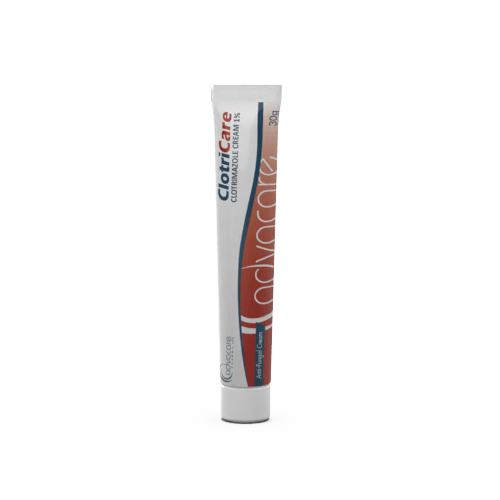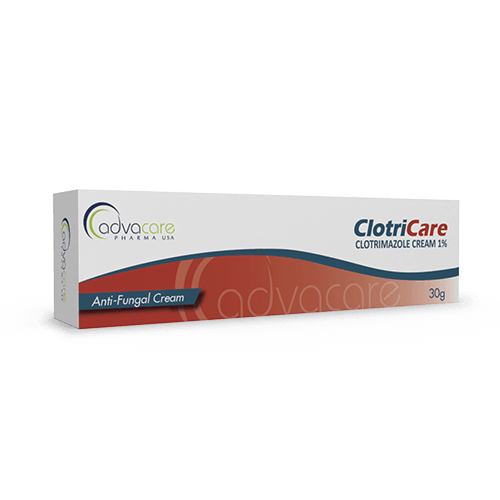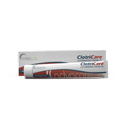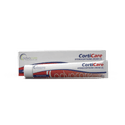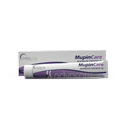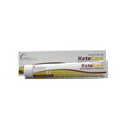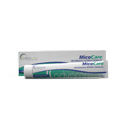- Home›
- Pharmaceuticals›
- Topicals›
- Medical Creams›
- Clotrimazole Cream
Clotrimazole Cream
Form
Dosage
Packaging
What is Clotrimazole?
Active Ingredients: Clotrimazole
Clotrimazole Cream is a topical antifungal drug used to treat fungal and yeast infections of the skin. It is indicated in the treatment of candidiasis and tinea, such as athlete's foot (tinea pedis), jock itch (tinea cruris), and ringworm (tinea corporis). This cream should only be applied topically to the skin.
Clotrimazole shows a broad antimycotic spectrum of activity against many species of pathogenic dermatophytes and yeasts. It is effective against Trichophyton rubrum, Trichophyton mentagrophytes, Epidermophyton floccosum, Microsporum canis, Candida species including Candida albicans, and Malassezia furfur. The mode of action is primarily fungistatic or fungicidal. It is rare for fungi to have a natural resistance to clotrimazole, making it a potent antifungal.
Clotrimazole also shows some activity against certain gram-positive organisms microorganisms (e.g. streptococci, staphylococci, Gardnerella vaginalis), and some gram-negative microorganisms (e.g. bacteroides).
Clotrimazole is a synthetic antifungal agent in the imidazole family. It works by inhibiting the biosynthesis of sterol ergosterol, an important element of the fungal cell membrane necessary for its metabolism and survival.
Clotrimazole is produced as a cream or spray, with a dosage of 10mg/g (1% w/w). Each 1g of cream contains 10mg of clotrimazole. The cream is packaged in a tube, which is available as a 20g, 30g, or 40g tube. The spray is manufactured as a 40ml spray bottle.
Clotrimazole + Betamethasone Cream is also available as a combination product, which is intended for severe or inflamed dermatological fungal infections.
This medication is produced and exported by AdvaCare Pharma. Clotrimazole Cream is manufactured in our factories in China, India, and the USA. We regularly inspect these manufacturing facilities to ensure they meet quality and safety standards.
Why are we a top Clotrimazole manufacturer?
AdvaCare Pharma is a US pharmaceutical company that manufactures Clotrimazole Cream, and our entire range of 50+ topical treatments in cream, ointment and gel dosage forms, under stringent GMP regulations. Our distinctive approach to business fosters a highly collaborative relationship with our pharmaceutical distributors. For the past 20 years we have established a reputation as a trusted Clotrimazole manufacturer, one of the 500+ pharmaceutical products in our comprehensive range, across more than 65 global markets.
Uses
What is Clotrimazole used for?
It is used to treat skin infections caused by mold (e.g. Trichophyton), fungi, or yeast (Candida).
It’s used for conditions such as:
- candidiasis due to Candida albicans
- jock itch (tinea cruris)
- ringworm (tinea corporis)
- pityriasis (tinea versicolor due to Malassezia furfur)
- candidal nappy rash, vulvitis, and balanitis
Clotrimazole may also be used to treat skin diseases with secondary infections due to susceptible fungi.
Can Clotrimazole Cream be used for diaper rash?
Clotrimazole Cream can be used for diaper rash that is caused by a suspected candida infection. It is important to consult with a doctor or healthcare professional before using any over-the-counter product to treat diaper rash in order to first determine the cause of the problem.
How is Clotrimazole Cream used?
This medication is manufactured as a sterile cream, which is intended for topical administration directly to the skin. Clotrimazole Cream is intended for external use only. It is not intended for ophthalmic use. For infections that cover a large area of the skin or are under hair, Clotrimazole Spray is recommended.
Always wash your hands with soap and water before and after using this medication. For infections affecting the feet, it is recommended to thoroughly wash and dry the feet, with special attention given to between the toes. After the feet are thoroughly dried, the medicine should be applied.
It is advised to continue treatment for the intended duration, even if symptoms improve. If treatment is stopped too early, symptoms may return. If symptoms have not subsided after 4 weeks, a physician should be consulted.
Can Clotrimazole Cream be applied on damaged skin?
This product should not be applied to damaged skin unless otherwise directed by a doctor. Care should be taken to avoid broken skin or open wounds while applying this medicine.
Where should Clotrimazole Cream be stored?
It is recommended to store this medicine in a cool, dry place. The container should be kept out of reach of children. Any medicines past their expiry date should be discarded.
What dose should be applied?
Adult Dosing Dosage may vary based on different medical indications:
- For cutaneous candidiasis, a small, thin layer of topical medicine should be applied to the affected area twice per day. Treatment should continue for 2-4 weeks, depending on the severity of the infection.
- For tinea corporis, a small amount of the topical medicine should be applied to the afflicted area and surrounding area. It should be applied twice a day for 2-4 weeks.
- For tinea cruris, a small amount of the topical medicine should be applied to the afflicted area and surrounding area. It should be applied twice a day for 2-4 weeks.
- For tinea pedis, a small amount of the topical medicine should be applied to the afflicted area and surrounding area. It should be applied twice a day for 2-4 weeks.
- For tinea versicolor, a small amount of the topical medicine should be applied to the afflicted area and surrounding area. It should be applied twice a day for 2-4 weeks.
Pediatric Dosing Recommended dosage for children may vary based on different medical conditions:
- For cutaneous candidiasis in children over 3 years old, a small, thin layer of topical medicine should be applied to the affected area twice per day. Treatment should continue for 2-4 weeks, depending on the severity of the infection.
- For tinea corporis in children over 3 years old, a small amount of topical medicine should be applied to the afflicted area and surrounding area. It should be applied twice a day for 2-4 weeks.
- For tinea cruris in children over 3 years old, a small amount of topical medicine should be applied to the afflicted area and surrounding area. It should be applied twice a day for 2-4 weeks.
- For tinea pedis in children over 3 years old, a small amount of the topical medicine should be applied to the afflicted area and surrounding area. It should be applied twice a day for 2-4 weeks.
- For tinea versicolor in children over 3 years old, a small amount of topical medicine should be applied to the afflicted area and surrounding area. It should be applied twice a day for 2-4 weeks.
Refer to a doctor or healthcare professional for the exact dosage and duration of treatment.
Who can use Clotrimazole?
Clotrimazole Cream can be used by adults and children, but caution is advised for specific groups of patients.
Pregnant This medicine is considered safe for use by pregnant women when under the supervision of a healthcare professional. Animal studies suggest that high oral doses of this drug may cause reproductive toxicity, topical treatment is not expected to cause harmful effects. Clotrimazole is minimally absorbed into the body through intact or inflamed skin, so it is unlikely to cause systemic effects.
Breastfeeding This medicine can be used by breastfeeding women. It is not known whether clotrimazole is excreted in human milk. Topical administration is not predicted to cause systemic effects.
Children Clotrimazole is considered safe for use in children if under the direction of a healthcare professional. It is not expected to cause additional side effects or other problems in this population.
Geriatric This medicine is considered safe for use in elderly patients. There is no specific information concerning the use of this medicine in this population compared with younger patients.
Side Effects
As with all pharmaceuticals, some unwanted effects can occur from the use of Clotrimazole Cream.
Common side effects include, but may not be limited to:
- mild irritation, burning, or stinging
- pruritus (itching)
- erythema
- localized edema
- urticaria
- peeling
- blistering
Serious reactions are uncommon, but they may include:
- signs of an allergic reaction
- severe blistering, burning, itching, or irritation
For a comprehensive understanding of all potential side effects, consult a medical professional.
If any symptoms persist or worsen, or you notice any other symptoms, please call your doctor.
Precautions
Do NOT use Clotrimazole Cream if:
- You are allergic to any of the ingredients.
- You are hypersensitive to any azole antifungal.
Before treatment, consult your doctor regarding any medications you are taking to address potential drug interactions. Some possible drug interactions may include amphotericin or topical medications containing nystatin.
This medication may not be suitable for people with certain conditions, so it is important to consult with a doctor if you have any health conditions.
This medicine should only be used during pregnancy and breastfeeding if the benefits outweigh the risks. Consult a doctor or healthcare professional before treatment.
You should avoid using other topical medications on the same area of your skin, unless directed by a doctor.
Tight-fitting or synthetic clothing may inhibit the healing of the infection. Only cover the treated area if it is recommended by a doctor.
Do not apply this medicine to open wounds, such as cuts or burns.
Some formulations of this product may contain benzyl alcohol. Benzyl alcohol has been associated with gasping syndrome in neonates.
This product may contain cetostearyl alcohol, which is known to cause some local skin reactions (contact dermatitis). Avoid smoking or walking near large flames after applying this medicine.
Topical clotrimazole is not expected to cause side effects that may impact the ability to drive or use machines.
References
Study to determine the efficacy of Clotrimazole 1% cream for the treatment of onychomycosis in association with the mechanical reduction of the nail plate
Onychomycosis is the invasion of nails by dermatophytes, yeasts, and molds, with T. rubrum and T. mentagrophytes being common causative organisms. Fungi typically invade the distal and lateral undersurfaces of the nail. Onychomycosis’s prevalence is estimated to be around 5–10% of the population, and it has been increasing in recent years.
Clotrimazole 1% cream is most often prescribed as a topical antifungal agent in the United Kingdom but has not been extensively documented for nail use.
The study included ambulant, healthy patients with no systemic medication history, no prior use of antifungal drugs, and sufficient circulation for healing as indicated by the ankle-brachial index. Microscopy and culture identified the infecting organism. Ninety-two infected nails were isolated over four years and patients were aged between 60–78 years. Nails were drilled every 14 days by the same operator, and the infected area was mapped.
Clotrimazole 1% cream was applied twice daily during the trial, and the percentage clearance rate was documented.
The conclusion of this research is that after 12 weeks, there was an average improvement of 96.2%, with complete resolution of infection in 80% of nails.

You might be interested in...
Why AdvaCare Pharma?
As an industry leader, we are aware of our responsibility to provide affordable and sustainable solutions to improve healthcare worldwide.

